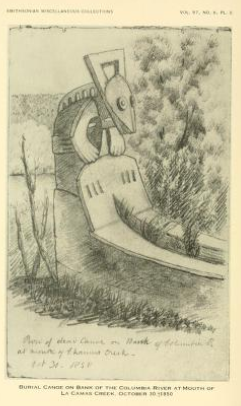Dead canoes: another “new old” word?

Handwritten caption by Gibbs: “Prow of dead Canoe on Bank of Columbia R at mouth of Chamus Creek, Oct. 30, 1850″ (“Plate 5”)
The Easter season (see yesterday’s post) may have been directing my thoughts towards death more than usual — leading to new discoveries like today’s.
I’ve recently pointed out here that, parallel to the long-known Chinook Jargon phrase míməlust-ílihi (dead-place = ‘graveyard; cemetery’), we can add to our dictionaries the phrases míməlust-tənəs-ílihi (dead-little-place = ‘graveyard island’) and míməlust-háws (dead-house = ‘grave house; mausoleum’).
Today, I argue, we can expand on that pattern with an expression ‘dead canoe’ that I infer existed in Chinuk Wawa (thus míməlust-kəním). This phrase occurs in at least two places that I know of.
The main source of evidence is one that seems quite strong to me: a drawing by the great early Chinuk Wawa expert George Gibbs done on the scene, squarely in the frontier era. I show it above. Gibbs himself captioned it as depicting a “dead canoe” in Chinookan country. Here is some additional information from the editor of a collection of Gibbs’s drawings:


from David I. Bushnell, Jr., “Drawings by George Gibbs in the Far Northwest, 1849-1851” (Smithsonian Miscellaneous Collections, volume 97, 1939), pages 5-6
By the way, “CH” in the above presumed spelling of the Jargon word (lá)kámás (the stress has been recorded in three different places in the word during its long history) may be significant. It implies an early pronunciation that was closer to Sahaptian x̣máš, which the Grand Ronde Tribes dictionary of 2012 points out as a likely etymology.
The other authority I’m putting forth for a Jargon expression míməlust-kəním is the turn-of-the-century photographer and researcher Edward S. Curtis. His monumental work, “The North American Indian”, has in volume 9 (“The Salishan Tribes of the Coast”, a reference to a “dead canoe covered with mats” on page 87:

(Curtis doesn’t mention any “dead canoes” on page 87 itself; but as a consolation, he does discuss Quinault “dead houses” there!)
Let me spell out my reasoning, in case it’s not clear yet: the phrase “dead canoe” is just plain not a thing in English, and never was.
A simple Google Books search, for instance, shows you that folks who grew up talking English have never had a habit of using this expression.
On the other hand, just as I argued with “dead house”, it makes perfect sense if “dead canoe” is a straight-across, literal translation from Chinuk Wawa.
In CW, míməlust-kəním is a perfectly grammatical compound noun.
And it’s not remarkable that some Wawa expressions simply never got written down; we’re constantly discovering more of them on this website, with every week that goes by.
In any case, aside from expanding our inventory of known historical Jargon use, this expression may be a useful one in the context of Indigenous cultural revitalization. If I’m not mistaken, there are present-day Native communities where canoe burial is returning.

Interesting that kəním shows up in this context. We have a lake up here by the (now called) “Canim”, so named by Wawa-speaking Freemen, deployed from Ft. Vancouver and south, on their way to Alexandria, etc., by HBC; they seem to have invested time specifically re-naming places of importance to their logistical and geographical maneuvering of supplies, people and furs (I.e.”Tranquille” as a quiet bit of water on Kamloops Lake shoreline to off-load cargo). It is my contention that some of these re-names may have been based on translations of local place meanings (unpronounceable to their tin-eared bosses), and then mapped in as such, thereby erasing the original names in common usage thereafter (like so much of Canada).As Wawa became in large part the trade language off-the-books (at least in the Southern Interior, with more low French-Joual and michif appearing farther north), we can more accurately pinpoint when the transition from Secwepemctsin (for instance), to Wawa took place. I find this website endlessly informative, as I conduct place-name research for Indigenous peoples…keep up the brilliant work. Cheers, J.
LikeLiked by 1 person